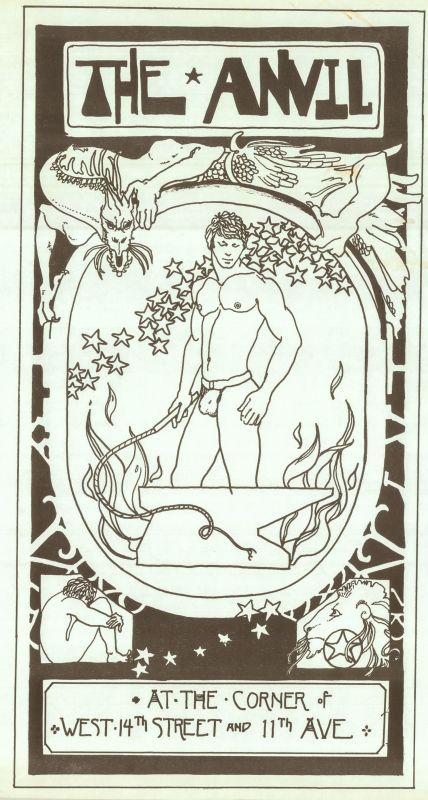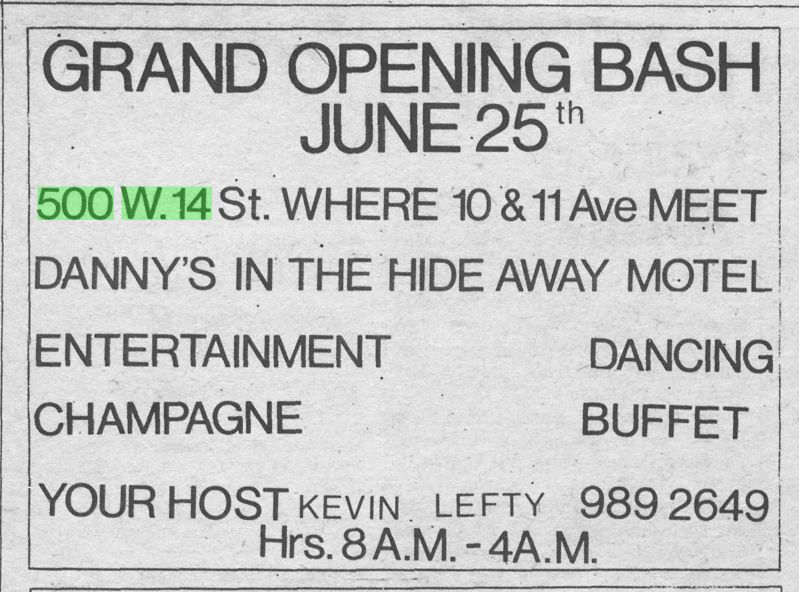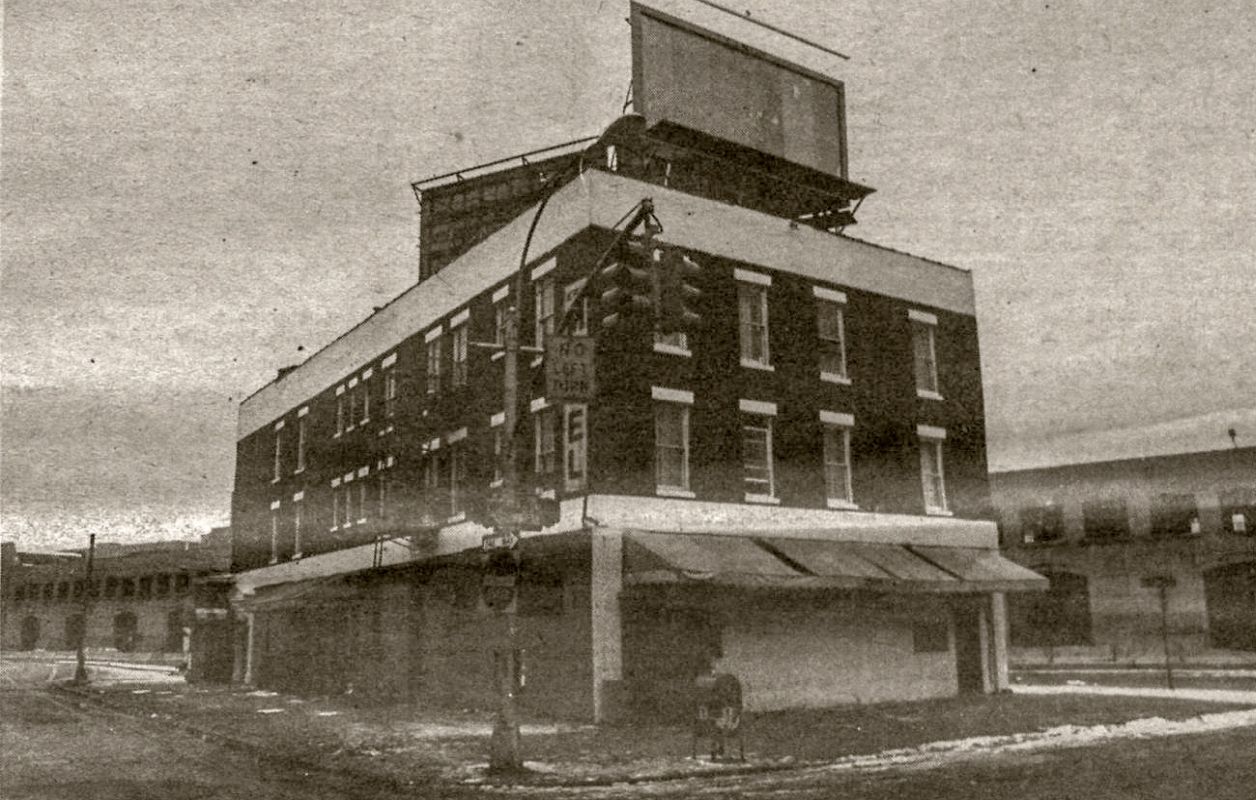overview
This small waterfront hotel in the Meatpacking District was the location from 1974 to 1985 of the Anvil, one of the most famous, or infamous, gay sex clubs in the city.
Before closing voluntarily after the City began to shutter gay venues due to AIDS, the Anvil also had a disco, live performances, sex exhibitions, and drag shows and attracted a celebrity crowd.
History
This small, three-story triangular building, along the West Side Highway at West 14th Street, was built in 1908 as the Strand Hotel. The Strand had a café and saloon, and its rooms were rented only to men, largely sailors from the trans-Atlantic steamships at the adjacent Chelsea Piers, and other waterfront workers. This section of the Hudson River was then the busiest waterfront in the world.
By the early 1970s, the building had become known as the Hideaway Motel. In June 1972, Danny’s Bar opened in the Hideaway, which was one of four gay bars in Manhattan, Brooklyn, and New Jersey that operated under the name “Danny’s.” An ad listed dancing and entertainment here. Gay Scene in January 1973 noted that it was then a leather bar known as the Meatrack. The same newspaper reported in April 1974 that it had a new name – the Anvil – and in May 1975 that it had live shows on Saturdays and Sundays. The New York Post later reported that the Anvil was run by the Liberation Social Club, incorporated in 1976, that the owner of record was Alan Goldstein of Queens, and that it was briefly intended for heterosexuals.
But the Damron Guide, in its first inclusion of the Anvil in 1977, denoted its “action” and “wild back room.” The Anvil became a very popular after-hours bar and disco, run as a private club to thwart the State Liquor Authority (SLA). Most patrons arrived at the entrance on 14th Street after 4:00 a.m., and there were frequently lines of hopeful patrons waiting to get in. A bouncer strictly controlled who was allowed to enter, with a preference for masculine men; women were prohibited (except for celebrities). The Anvil operated on two levels. On the ground floor was the main bar with go-go boys, a dance floor, and a performance area. In its earlier days, the Anvil became notorious for its sex exhibitions here, and later there were periodic drag shows and other types of performances. Downstairs was a small bar, a screen showing porn, and behind that was a large “cave-like” backroom for sex. Writer Will Kohler opined that “The Anvil was one of the hottest, sleaziest, and most glorious places to be for gay men of that period.” Perhaps the only other sex club that equaled, or surpassed, the Anvil’s fame was the nearby Mineshaft.
The Anvil’s notoriety attracted a celebrity crowd, many of these visitors as observers only, which, according to earlier patrons, changed its atmosphere. Among the notables who went here were artist Andy Warhol, writer Truman Capote, musicians Freddie Mercury and Lou Reed, and German filmmaker Rainer Werner Fassbinder. Felipe Rose (tribal nation: Taino/Lakota) began his career dancing at the Anvil, prior to being selected as “the Indian” for the musical group the Village People.
The Anvil was the unfortunate site of two murders in 1979. By 1984 it had been raided numerous times by the SLA and the police, but managed to continue in operation. It was surveilled by police under the recently-enacted Police Padlock Law, which enabled the closing of places with illegal activities. The owner and managers were accused of illegally operating without a liquor license, and as a not-for-profit, without paying state taxes.
Then, with the advent of the AIDS epidemic, in October 1985, New York State authorities issued emergency regulations allowing local officials to immediately close any “homosexual” places where “high-risk sexual activities” took place. In November, then-mayor Ed Koch shut down the Mineshaft, which was the first gay venue closed by the City as part of AIDS prevention measures. The Anvil closed voluntarily on November 9.
The Liberty Inn continued to operate here over the next four decades, as a reportedly clean, and nearly upscale, by-the-hour hotel. Its neighborhood, the Meatpacking District, however, had increasingly gentrified around it. Hyundai acquired the property in September 2023, and its future is unclear.
Entry by Jay Shockley, project director (September 2023).
NOTE: Names above in bold indicate LGBT people.
Building Information
- Architect or Builder: Richard R. Davis
- Year Built: 1908
Sources
“107 colorful years at a Meatpacking District motel,” Ephemeral New York, September 7, 2015, bit.ly/3rAEk4u.
Alex Vadukul, “For Sale: The ‘Sexiest’ Hourly Rate Hotel in Manhattan,” The New York Times, August 10, 2022.
Bob Damron, Bob Damron’s Address Book (San Francisco: Bob Damron Enterprises, 1973-1977).
Danny’s Hideaway ads, GAY, July 10 and August 21, 1972.
D.D. Griffo, “Cruising in Fun City,” Gay Scene, May 1975, 9.
“Leather Scene,” Gay Scene, April 1974, 19.
James Barron, “Throughout the City, Finding Traces of the Titanic,” The New York Times, April 11, 2012.
Marcos Bisticas-Cocoves, “New York Locks Up the ‘Mineshaft’,” Gay Community News, November 23, 1985, 1-2.
Meatrack listing in “Bar Guide,” Gay Scene, January 1973, 22.
Robert Drake, “Catching the 12:55,” Reflections of a Rock Lobster, January 20, 2006, bit.ly/466pmSJ.
Sebastian Morris, “Hyundai Acquires Commercial Property At 500 West 14th Street In Meatpacking District, Manhattan,” New York YIMBY, September 19, 2023, bit.ly/46A4QK8.
Steven C. Arvanette, “Anvil Targeted for Shutdown,” New York Native, December 17-30, 1984, 12.
“Tax Lawyer is a Key Man at 3 AIDS Dens,” New York Post, November 14, 1985, 4, 30.
Will Kohler, “NYC – Forgotten Gay History: The Anvil 500 W. 14th Street NYC (1974 to 1986),” Back2Stonewall, 2017, bit.ly/3F0Esx1.
Do you have more information about this site?
This project is enriched by your participation! Do you have your own images of this site? Or a story to share? Would you like to suggest a different historic site?













